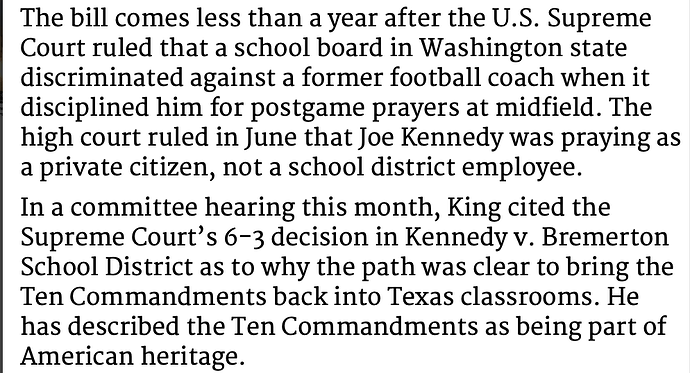This is the most relevant part from Scalias descent, as it references beyond just a public display of Ten Commandments but cases that had a mandate in schools and other places (see 1980 case for example). Basically ones that served no secular purpose. He is using those cases to show how far the court has shifted from that position of something struck down because it only has a religious purpose to something struck down because it has a religious purpose in addition to a secular one.
Now he doesn’t fully endorse that logic either, but his comments on it are much softer “not necessarily invalidating” vs the rest of the dissent.
I’m not saying this court would guarantee it is struck down, since who knows with them. I’m guessing Alito, Thomas, and Uber-religious Barrett would vote to uphold it. And they’ve shown willingness to ignore precedent. But if something was almost a bridge too far for Scalia I’m not certain Kavanaugh/Gorsech would both go for it.
Second, the Court replaces Lemon ’s requirement that the government have “a secular . . . purpose,” 403 U. S., at 612 (emphasis added), with the heightened requirement that the secular purpose “predominate” over any purpose to advance religion. Ante , at 15–17. The Court treats this extension as a natural outgrowth of the longstanding requirement that the government’s secular purpose not be a sham, but simple logic shows the two to be unrelated. If the government’s proffered secular purpose is not genuine, then the government has no secular purpose at all. The new demand that secular purpose predominate contradicts Lemon ’s more limited requirement, and finds no support in our cases. In all but one of the five cases in which this Court has invalidated a government practice on the basis of its purpose to benefit religion, it has first declared that the statute was motivated entirely by the desire to advance religion. See Santa Fe Independent School Dist. v. Doe, 530 U. S. 290, 308–309 (2000) (dismissing the school district’s proffered secular purposes as shams); Wallace , 472 U. S., at 56 (finding “no secular purpose”) (emphasis added); Stone v. Graham , 449 U. S. 39, 41 (1980) (per curiam) (finding that “Kentucky’s statute requiring the posting of the Ten Commandments in public school rooms has no secular legislative purpose ”) (emphasis added); Epperson v. Arkansas , 393 U. S. 97, 107–109 (1968). In Edwards , supra , the Court did say that the state action was invalid because its “primary” or “preeminent” purpose was to advance a particular religious belief, 482 U. S., at 590, 593, 594, but that statement was unnecessary to the result, since the Court rejected the State’s only proffered secular purpose as a sham. See id. , at 589. I have urged that Lemon ’s purpose prong be abandoned, because (as I have discussed in Part I) even an exclusive purpose to foster or assist religious practice is not necessarily invalidating. But today’s extension makes things even worse. By shifting the focus of Lemon ’s purpose prong from the search for a genuine, secular motivation to the hunt for a predominantly religious purpose, the Court converts what has in the past been a fairly limited inquiry into a rigorous review of the full record.[Footnote 9] Those responsible for the adoption of the Religion Clauses would surely regard it as a bitter irony that the religious values they designed those Clauses to protect have now become so distasteful to this Court that if they constitute anything more than a subordinate motive for government action they will invalidate it.
